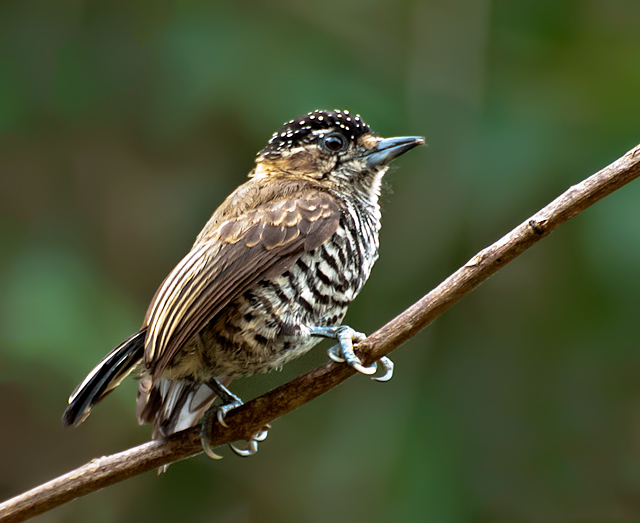The
white-barred piculet (
Picumnus cirratus) is a species of
bird in the family
Picidae, the
woodpeckers,
piculets, and
wrynecks. It is found in south-eastern
Brazil south and west to the
Pantanal, and into south-eastern
Bolivia,
Paraguay and northern
Argentina. A
disjunct population occurs in the coastal parts of
French Guiana, south to the Brazilian state of
Amapá and west along the lower
Amazon River up to around the
Tapajós River. A small, apparently isolated population is found in southern
Guyana and adjacent
Roraima. Its natural
habitats are subtropical or tropical dry
forests, subtropical or tropical moist lowland forests, and heavily degraded former forest.
Taxonomy
The white-barred piculet was first described in 1825 by the Dutch zoologist
Coenraad Jacob Temminck. It was given the name
Picumnus cirratus, the specific name meaning "curly headed",
cirrus being Latin for a ringlet or curl.
[2] Molecular studies show that it is the sister species to
P. temminckii and also closely related to
P. dorbignyanus, and at different times these species have been treated as synonymous. Six subspecies are recognised;
P. c. confusus found in southwestern Guyana, northern Brazil and French Guiana; the Marajo piculet,
P. c. macconnelli found in the eastern Amazon region of northeastern Brazil;
P. c. thamnophiloides found in southeastern Bolivia and northeastern Argentina;
P. c. tucumanus found in northwestern Argentina; the Pilcomayo piculet,
P. c. pilcomayensis found in southeastern Bolivia, Paraguay and northeastern Argentina; and the nominate subspecies
P. c. cirratus found in southeastern Brazil, southern Mato Grosso and eastern Paraguay.
[3]
The
taxonomy of this species is difficult; the races
pilcomayensis,
thamnophiloides and
tucumanus intergrade in northern Argentina and are sometimes considered a separate species, and
pilcomayensis intergrades with
cirratus in eastern Paraguay. The northern subspecies,
confusus and
macconnelli may also be a distinct species.
[3] The white-barred piculet also
hybridizes widely with several other species of piculet where their ranges overlap; these include the
varzea (
P. varzeae) along the Amazon River, the
ochre-collared (
P. temminckii) in southeastern Brazil, the
ocellated (
P. dorbignyanus) in Bolivia, and the
white-wedged piculet (
P. albosquamatus), also in Bolivia.
[4][5]
Description
The
white-barred piculet is between 9 and 10 cm (3.5 and 3.9 in) long. The
sexes differ in that the male has red streaks or a solid red patch on
the fore-crown, while the female lacks this. The rest of the crown is
black, speckled with white. The upper parts of the body are tan or
olive-brown, faintly barred with white, and the main flight feathers are
chocolate brown. The ear coverts and cheeks are olive brown and there
is a white streak above or behind the eye. The lower cheeks, chin and
throat are white, faintly barred with black. The underparts are white or
cream, boldly barred with black, the broadest stripes being on the
belly and flanks. The tail is chocolate brown apart from the central
pair of feathers which are white, and the two outer pairs which have the
inner webs white near the tip. The iris is brown, the orbital ring
bluish-grey, the beak black and the legs grey.
[6]
Distribution and habitat
There
are two different sub-populations of this bird on either side of the
equator in South America. The northerly population is in Guyana,
northwestern French Guiana and northern Brazil. The southern population
is in southeastern Brazil, eastern Bolivia, eastern Paraguay and
northern Argentina. The white-barred piculet occupies various habitats
including wet and dry woodland, forest verges, thickets, gallery
forests, wooded savannah, scrub, bamboo clumps, vines, creepers and
overgrown parks and gardens at elevations of up to about 2,200 m
(7,200 ft). It is a resident, sedentary species.
[6]
Ecology
The
white-barred piculet usually forages singly, but may join small mixed
species flocks. It feeds on ants, their larvae and eggs, beetle larvae
and other small invertebrates. It actively drills holes in wood and may
also feed on sap that oozes from puncture marks. It sometimes follows
swarming ants. Northern races breed between July and December, while
southern races do so between September and March. The nest is a hole in a
tree a few metres off the ground.
[3][6]
Status
This bird
has a very large range and is described as being common. The population
is believed to be in slow decline, because of ongoing destruction of
the rainforest, but this is not happening at such a rate as to make the
species vulnerable, and the
International Union for Conservation of Nature has assessed its conservation status as being of "
least concern".
[1]

No comments:
Post a Comment
Note: Only a member of this blog may post a comment.